The History Of Tatra
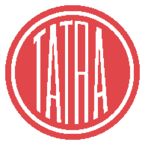
Tatra is a vehicle manufacturer in Kopřivnice, Czech Republic. The company was founded in 1850 as Nesselsdorfer Wagenbau-Fabriksgesellschaft, a wagon and carriage manufacturer, and in 1897 produced the first motor car in central Europe, the Präsident. In 1919 it changed its name to Tatra after the Tatra mountains. Tatra is the third oldest car maker in the world after Daimler Mercedes-Benz and Peugeot. Production of Tatra cars ceased in 1999 but the company still produces a range of primarily all-wheel-drive 4x4, 6x6, 8x8, 10x10, and 12x12 trucks.
Ignác Šustala (1822 - 1891), founder of the company in Kopřivnice, Moravia, started the production of horse-drawn vehicles in 1850. In 1891 he branched out into railroad cars manufacture, naming the company Nesselsdorfer Wagenbau-Fabriksgesellschaft, and employed Hugo Fischer von Roslerstam as technical director in 1890. After the death of Šustala, von Roslerstam took over running the company and in 1897 he bought a Benz automobile. Using this for inspiration the company made its first car, the Präsident, which was exhibited in 1897 in Vienna. Orders were obtained for more cars and under the direction of a new young engineer Hans Ledwinka (1878-1967) ten improved cars were made.
The first car to be totally designed by Ledwinka came in 1900 with the Type A with rear mounted 2714cc engine and top speed of 40kilometres per hour (25mph), 22 were made. This was followed by the Type B with central engine in 1902 but then Ledwinka left the company to concentrate on steam engine development. He returned in 1905 and designed a completely new car, the Type S with 3308cc 4 cylinder engine. Production was badly hit in 1912 with a 23-week strike and Hugo Fischer von Roslerstam left the company.
After the World War I Nesselsdorfer Wagenbau was renamed Kopřivnice vozovka, and in 1919 the name Tatra was given to the car range. Leopold Pasching took over control and in 1921 Hans Ledwinka returned again to develop the revolutionary Tatra 11.
The new car, launched in 1923 featured a rigid backbone tube with swinging semi-axles at the rear giving independent suspension. The engine, front mounted, was an air cooled two cylinder unit of 1056cc. The T 11 was replaced in 1926 by the similar T 12 which had four wheel brakes. A further development was the 1926 T 17 with a 1,930cc water-cooled six- cylinder engine and fully independent suspension. In 1927 the company was formally renamed Tatra a.s..
Tatra's specialty was luxury cars of a technically advanced nature, going from aircooled flat-twins to fours and sixes, culminating (briefly) with the OHC 6 litre V12 in 1931. In the 1930s, under Austrian engineer Hans Ledwinka and his son Erich, and protected by a high tariff and absence of foreign assemblers, Tatra then began building advanced, streamlined cars, which started in 1934 with the large Tatra T77, the world's first production aerodynamic car. The fastback T77's drag coefficient of 0.212 is rarely bettered even by the sleekest of modern cars. It featured (as did almost all subsequent big Tatras) a rear-mounted, air-cooled V8 engine, which was in technical terms very sophisticated for the time.
Ledwinka discussed his ideas with Ferdinand Porsche who used many Tatra design features in the 1938 Kdf-Wagen, later known as the VW Beetle. This is particularly evident when compared with the smaller T97 model which had a rear-mounted, air-cooled, flat-4 engine and rounded body styling. Tatra immediately started legal action, but the matter was not resolved until 1961 when Volkswagen was ordered to pay 3,000,000 Deutsche Marks in damages.
After the 1938 invasion of Czechoslovakia by Nazi Germany, Tatras continued in production, largely because Germans liked the cars. Many German officers met their deaths driving heavy, rear-engined Tatras faster around corners than they could handle. At the time, as an anecdote, Tatra became known as the Czech Secret Weapon for the scores of officers who died behind the wheel; at one point official orders had to be issued forbidding German officers from driving Tatras.
The factory was nationalised in 1946 when the Communist Party came to power. Although production of prewar models continued, a new model, the Tatra T600 Tatraplan was designed -- the name celebrating the new Communist planned economy. It went into production in 1947. In 1951, the state planning department decided that the Tatraplan should henceforth be built at the Skoda plant in Mladá Boleslav, leaving Tatra free to concentrate on trucks, buses and railway equipment.
Main article: Tatra T603A mere three years later, amid much dissatisfaction among officialdom about the poor-quality official cars imported from Russia, Tatra was again given permission to produce a luxury car, the famous Tatra T603. A fair successor to the prewar cars, it was also driven by a rear-mounted, air-cooled V8 and had the company's trademark aerodynamic styling. Uniquely, the Tatra T603 featured three headlights, and the first prototypes had a central rear stabilising fin, though this was lost for production. Fitted with almost American-style thick chrome bumpers with bullets (a.k.a. Dagmar bumpers), the Tatra T603 was an amazing looking car for 1955. Looks weren't all it had going for it; performance was spritely for a large, six-seater car, and the ride was smooth as glass. Almost entirely hand-built, Tatras were not for everybody; normal citizens could not buy them. They were reserved for Party elites, Communist officials, factory presidents and other notables, as well as being exported to most other Communist nations as official cars. Even Fidel Castro had a white Tatra T603, custom-fitted with air conditioning.
Tatra T603s were built until 1975, a twenty-year era as one of Communism's finest cars. Numerous improvements were made over this time, but not all the new cars built in this period were actually new. When a new Tatra replaced an old, the old vehicle was returned to the factory. There, it was upgraded to modern condition, refinished, dubbed new and sent out again as a putatively new vehicle to replace another older Tatra. This makes it hard to trace the history of surviving vehicles.
Main article: Tatra T613In 1968 a replacement was developed; the Tatra T613. It was styled by the Italian styling house of Vignale and was a more modern, less rounded shape. It was not until 1973 that any were actually produced by the factory, and volume production did not begin until the following year. Although the layout remained the same, the body was all new, as was the engine, being equipped with four overhead camshafts, a higher capacity (3495 cc) and an output close to 165bhp (123kW; 167PS). In addition, it had been moved somewhat forward for improved balance. These cars were built in 5 series and several modifications until 1996. It is a tribute to Vignale's excellent styling that they did not look dated until rather late in that time period. Over 11,000 cars were built, slowing to a trickle of but a few dozen a year towards the end as Tatras began to seem more and more outdated.
1898-1914 Beginning
The first truck manufactured at Kopřivnice in 1898 was a flatbed with 2 liquid cooled side by side mounted two cylinder Benz engines each at 2.7 L capacity with total power output of 8.8 kW (12 hp) placed after the rear axle and cargo capacity of 2.5 ton. The unique feature of the engines setup was that the engines could be operated sequentially depending on the load requirements. No 1 engine was started via a cranking handle and had a flywheel attached and No 2 engine without the flywheel was connected via a gear clutch and started by the first engine already running. The second truck manufactured was once again a flatbed R type of 2.5 ton cargo capacity build in 1909. Powered by liquid cooled petrol four cylinder engine of 4.1 L capacity and power output of 18.4 kW (25 hp) with the engine placed above front axle which is the conventional design to this day. The vehicle featured solid rubber tyres and semi-elliptic leaf spring suspension. In 1910 Tatra manufactured its first bus the Omnibus type SO with total production of 5 units.
1914-1922 Serial Production
The first true serial truck production at Tatra was instigated by the beginning of World War I. In the year 1914 there were only 2 trucks made, type T 14/ 40 HP, however by the 1915 end the production jumped to the total of 105 TL-2 units and the following year 1916 the numbers rose to total of 196 TL-2 and 30 TL-4 trucks.The biggest volume of trucks produced at the time peaked in 1917 with 19 TL-2 and 303 TL-4 models, after that production declined and the similar amount of vehicles of one type manufactured in an year was not achieved or surpassed until 1936 with the T 27 model. Technically models TL-2 and TL-4 were almost identically designed, in fact TL-4 evolved from TL-2 where both had liquid cooled OHC engines of max power output of 25.7kW (35PS; 34hp). The TL-2 had a GVM 2,100kg (4,630lb) and 4,000kg (8,818lb) GCM, TL-4 had 2,700kg (5,952lb) GVM and 6,700kg (14,771lb) GCM respectively. Both types remained in production in small series until 1927. The TL-4 is considered the first truck to come out of NW (Nesselsdorfer Wagen-bau) to carry the name Tatra in 1919.
1923-1938 Tatra Concept
After the introduction of Tatra 11 and Tatra 12 cars with their distinctive backbone tube design and swing axles , Tatra introduced its first truck on the same basis, the light utility Tatra 13 powered by 2 cylinder air-cooled petrol engine with power output 8.8 kW (12 hp) and 1,000kg (2,205lb) cargo capacity. Further models followed and in 1926 T23 and T24 were introduced nicknamed "bulldogs" which could be considered Tatra's precursors to COE designed trucks. Improved version T13 introduced as T26 with more powerful 4 cylinder flat air-cooled engine and in six wheeler chassis created capable offroad light utility truck which later evolved in to T72 model which was heavily used by Czechoslovakian army at the time and was also manufactured under license by the french company Lorraine-Dietrich. In 1933 Tatra build limited series of T25 heavy artilery hauler with 4 and 6 cylinder petrol engines. The most popular Tatra truck before World War II was type T27 powered by 4 cylinder petrol or diesel engines and remained in production for nearly 17 years (1930-1947) with total production of 7,620 units ,by adding an extra axle to the rear the type T28 was created however, it was not successful and only limited production resulted in a mainly bus chassis. In the period from 1931 to 1938 Tatra also built a small utility truck based on the chassis from T30 named Tatra T43 which remain popular with small bussines owners. T72 model successfully continued the line to T82 built mainly for military in cargo and personel transport between 1935-1938 and further to T92 and T93 built for Romanian army from 1938-1941 which were identical except T93 had also a driven front axle.
1939-1956 The Legend Born
Main article: Tatra T111Following the Nazi occupation of Czechoslovakia the production at Kopŕivnice was annexed by Germans for the supply of trucks needed by Wehrmacht. Apart from the existing line up of T27, T92/ 92 a new heavy truck T81 commenced the production featuring liquid cooled 12.5 L V8 diesel engine with power output 118kW (160PS; 158hp) in 6x4 axle configuration. This vehicle evolved in 1942 into legendary T111 which continued its production until 1962 with the total of 33,690 unit made. T111 also featured Tatra's first air-cooled diesel engine a massive V12 originally designed for the armoured Sd Kfz. 234 Puma. After the war T111 contributed heavily into rebuilding effort in Central and Eastern Europe and for its exploits at Far East of USSR had a memorial built at Magadan Siberia.
1957-1982 Eastern Block Finest
Main article: Tatra T138 Main article: Tatra T148 Main article: Tatra T813The decision to replace aging but reliable T111 was taken in 1952 based on central planning economy of socialist government where directive was made to Tatra N.P. that it should concentrate on the manufacture of 7 to 10 ton capacity commercial vehicles and in 1956 first T137 and T138 trucks were exhibited at Czechoslovak machinery expo in Brno. The production of T111 however continued alongside T138 series until 1962. T138 itself continued in production until 1969 when it was replaced by improved T148 where designers main target was increase in power output, reliability and product improvements.
In 1967 Tatra commenced a production of one of its famous off-road trucks the T813 using its modular construction technology, the model incorporated the latest trends in commercial vehicles design such as COE cabin , wide profile tyres e.t.c, it also featured new V12 engine and all version for the military had a central tyre inflation/ deflation system standard. T813 was designed to tow loads up to 100 ton GCM and it was a familiar sight on the roads in Czechoslovakia hauling large often over-sized loads.
1982- 2008 T815 and Beyond
Main article: Tatra T815After the 53-rd session of CMEA council a directive that Tatra N.P. would be a sole supplier of off oad commercial vehicles of <12 ton capacity for Eastern Block countries, led to a modernization of company and its production models. Following extensive testing including at Siberia the type T815 was introduced in 1982 and production started in 1983. Comparing to previous models T815 was made of 142 main assembly components as opposed to 219 main assembly components of its predecessor. The engines power output was increased up to 45% and a new COE tilt-table cabin was introduced. Modular engine designed resulted in V8 , V10 and V12 engines with or without turbocharger. T815 was upgraded in 1994 to T815-2 with minor cosmetic changes and improved ergonomics and safety. The next facelift in 1997 brought in the new exterior design cabin TerrNo1 with all new interior with better sound and heat insulation however the cabin design is based on the original so it can actually be retrofitted to all T815 built since 1993. In 2000 the TerrNo1 cabin is face-lifted again and for the first time there is an option to fit liquid cooled engines. Following further improvements in 2003 T815 gets new Euro3 T3C V8 engine mated to all new 14 speed range+split gearbox as well as option for engines from other suppliers most notably CAT, Cummins, Renault, Deutz and MTU with its "monster" 22.5 Litre V12 and up to 620kW (843PS; 831hp) power output! In September 2006 Tatra introduced its Euro4 compliant turbocharged T3D engine with the SCR exhaust technology and in February 2008 the worlds's first Euro 5 compliant aircooled diesel engine based on T3D engine
Th evolution of Tatra T815 would not be complete without mentioning its derivates T816 (T815-6) Armax and FORCE series which had its origin back in 1993 when Tatra participated in the tender process for heavy duty off road trucks for UAE army and after two years of bidding the company was successful in securing a contract worth $ 180 million. The resulting model became known as T816 "LIWA" (Arabic for "desert". The latest model for the military customers is T817(T815-7) marketed as high-mobility heavy-duty tactical truck with low profile cabin for C-130 Hercules transportability for NATO member countries armed services.
Tatra also went back to its roots and decided to produce once again a bonneted heavy duty off road truck to continue the successful line started with T111, so in 1999 the T163 Jamal was put in to full production after first prototypes were built in 1997 and followed extensive testing including at Siberia, as a heavy duty dump truck, once again based on proven backbone tube chassis construction with the cabin designed by Jiří Španihel The T163 6x6 is used mainly on construction sites and in quarries.
Tatra was also a successful bidder for the Czech Army replacement of aging Praga V3S medium off-road truck with T810 which technically is not "genuine" Tatra as its origin goes back when former Czech company ROSS in partnership with Renault Trucks obtained contract to supply the army with medium off-road truck the "ROSS R210 6x6". The company however went bankrupt in 1998 and the Tatra bought full rights to the design, than modernized and reintroduced it as T810 while continuing cooperation with Renault. Under the deal Renault supplies the cabins and the engines, Praga supplies axles and transmissions, however the whole project have been dodged by controversy due to the way Tatra had obtained the contract, its relationship with supplier Praga and the subsequent court case brought on against it by Praga.
With orders and production almost at a standstill after the fall of Communism Tatra decided to stop building the T613 in 1996. An attempt was made to produce an updated version, the Tatra T700; it was largely based on the old car, with updated body panels and detail. Sales were poor, and having in its history produced a total of 90,000 cars, Tatra finally abandoned their manufacture in 1999 to concentrate on trucks.
The United States Terex Corporation acquired the majority ownership (71%) of Tatra in late 2003. As of late 2006, however, majority ownership (80.51%) lies in the hands of Tatra Holdings s.r.o., an international consortium comprising Vectra Limited of U.K., Sam Eyde of the U.S., KBC Private Equity of Belgium, Meadowhill s.r.o. of Czech Republic and Ronald Adams of the U.S. On 15 December 2006, a contract was signed between Tatra and the Czech Republic for 556 trucks at roughly $130,000,000 U.S., or 2,600,000,000 Czech Crowns. This contract was signed in lieu of replacement of older military vehicles.
In April 2007 Tatra announced that it had already matched its production in 2006 and produced 1,600 vehicles. In 2007 Tatra plans to produce between 2,300 and 2,500 vehicles. In contrast to previous years, Tatra has increased employment by the hundreds within the past two quarters, has reversed previous errors, and is growing again. Although there have been many struggles in the past decade, the company still remains one of the great prides of Czech industry and has proven to be a valuable asset to international engineering, with its unique assembly and production methods and designs.
Tatra has a truck-building joint venture in India called Tatra Vectra Motors Ltd, formerly called Tatra Trucks India Ltd. It is a joint venture between Tatra and the Vectra Group from England.
In February 2008, Tatra announced the world's first (and so far, only) air-cooled engine meeting the new Euro 5 standards. The press release claims 7.5 times lower emissions of particulates and 3.5 times lower emission of nitrogen oxides compared to the previous engine. Further, production of air-cooled engines should significantly reduce the production of greenhouse gasses due to the absence of liquid cooling systems. All Tatra vehicles from February 2008 onwards should use the new engine. A month later, Tatra CEO Ronald Adams told the The Prague Post Tatra could return to producing passenger cars, saying 'we would not come back to compete with the large automobile mass producers such as Volkswagen, Škoda, General Motors, Ford, etc. But we might come back with a replica of the old Tatra cars using a current undercarriage and driveline from one of the major automotive producers.' The company has launched a feasibility study, hoping to produce one thousand replicas of their legendary Tatraplan and 603 cars in 2010.
In July 2008 pictures of a fuel cell concept car designed by Mike Jelinek, the Tatra 903, were shown.
Passenger cars
- Tatra 11
- Tatra 12
- Tatra 17
- Tatra 57: Tatra 57 A and Tatra 57 B
- Tatra 75
- Tatra V570
- Tatra T77
- Tatra T77a
- Tatra T80
- Tatra T87
- Tatra T97
- Tatra T107
- Tatra T600 Tatraplan
- Tatra T603
- Tatra T613
- Tatra T700
Trucks
- Tatra T13
- Tatra T26
- Tatra T27
- Tatra T43
- Tatra T81
- Tatra T111
- Tatra T128
- Tatra T141
- Tatra T805
- Tatra T138
- OT-64 SKOT Tatra engine powered 8x8 armored personnel carrier
- Tatra T148
- Tatra T813
- RM-70 8x8 armored multiple rocket launcher based on Tatra T813
- Tatra T815
- Tatrapan 6x6 Armored vehicle based on the Tatra 815 chassis.
- Tatra T810
- Tatra T163 Jamal
- Tatra T816
- Tatra T817
- Tatra Force
- Tatra TERRNo1
- Tatra Armax
From Wikipedia, the free encyclopedia
More About Tatra
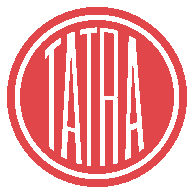
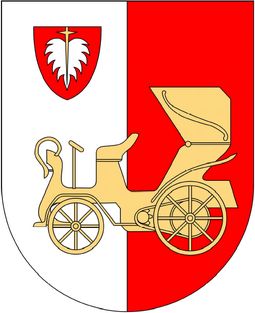
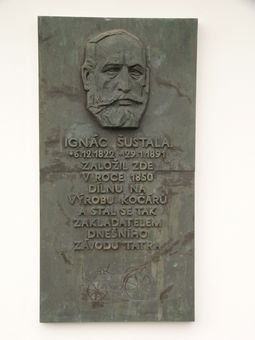
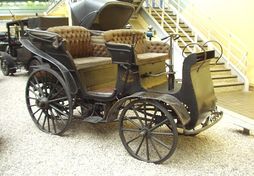
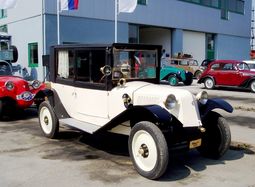
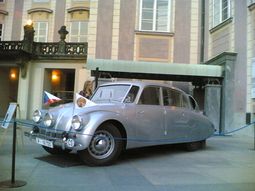
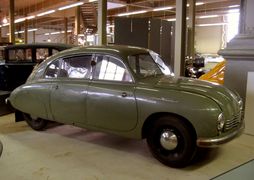
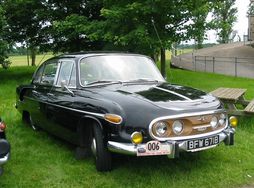
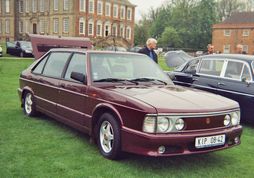
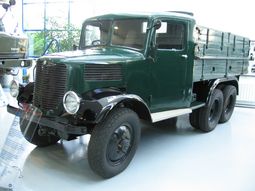
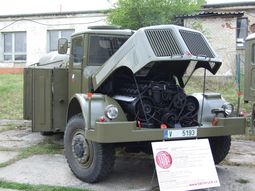
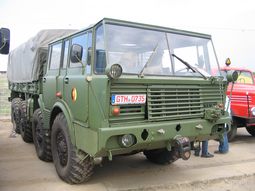
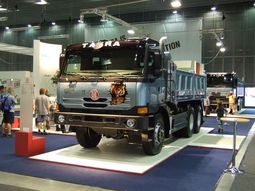
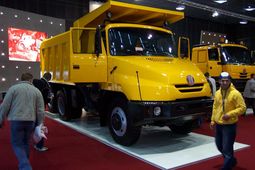
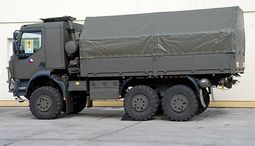
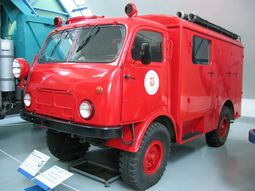
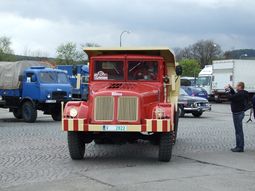
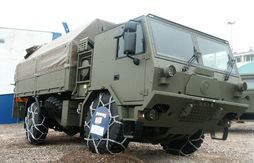
|